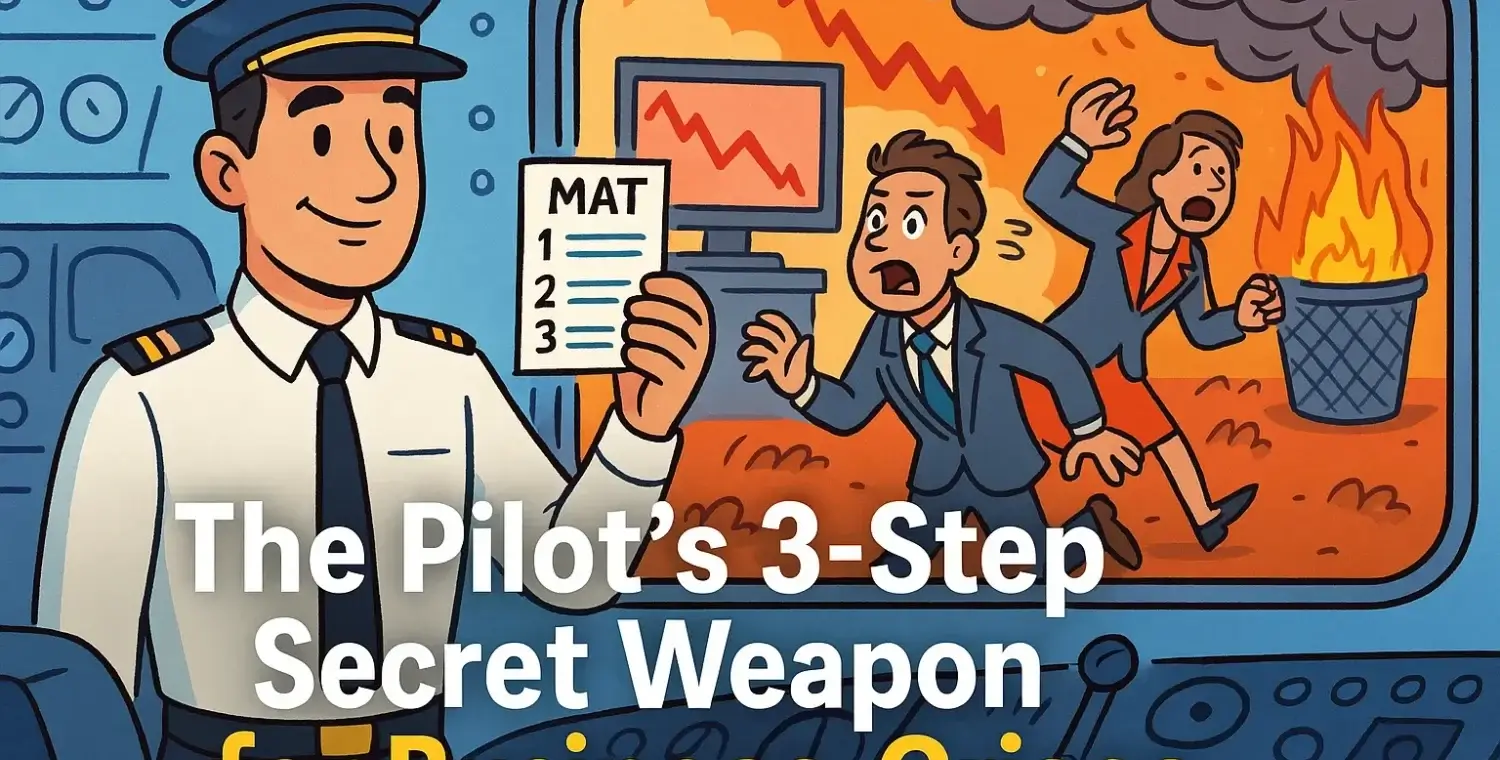Alright, let’s talk about that feeling. That ice-water-in-the-veins moment when serious turbulence hits your business. The sinking in your stomach feeling.
Maybe a major client pulls their account without warning. Maybe your biggest competitor launches a surprise attack. Maybe a key system crashes right before month-end. Or maybe, like that time over the Nevada desert for me, something critical just breaks.
What’s the typical reaction in the business world? Often, it’s controlled panic masquerading as decisive action. Scrambled meetings, knee-jerk decisions, finger-pointing, maybe some shouting. We react, we flail, we hope for the best. Sound familiar?
Pilots can’t afford that luxury. When alarms blare at 30,000 feet, panic is deadly. That’s why we rely on ingrained procedures and mental frameworks honed through relentless training. One of the most fundamental? A simple, powerful 3-step process that acts like a cognitive fire extinguisher, allowing us to navigate chaos with clarity and control, and it’s a core part of the ‘Built to Soar’ approach we explore in the book. I call it the pilot’s secret weapon for handling any unexpected emergency, and it translates perfectly to the business battlefield.
It’s called MAT:
- Maintain Aircraft Control
- Analyze the Situation
- Take Proper Action
Let’s break down how this “secret weapon” works and how you can use it the next time your business hits unexpected turbulence.
Step 1: Maintain Aircraft Control (Fly the Plane!)
When that engine fire warning lit up my cockpit, my absolute first instinct had to be “Fly the airplane.” Keep the wings level, maintain altitude and airspeed. Don’t let the emergency cause a secondary disaster, like losing control of the aircraft while distracted. Stabilize the situation first.
- Business Translation: Your biggest competitor just slashed prices. Your gut screams “Match them NOW!” Hold up. Before you react to the external threat, maintain control of your own operation. Are your sales processes still running? Is your team still focused? Is customer service still functioning? Don’t make panicked, emotional decisions that disrupt your own stability. Keep the core business flying smoothly while you figure out the next move. Don’t make things worse by introducing internal chaos on top of the external threat. Secure your immediate position.
- Ask Yourself: What are the critical functions that must continue uninterrupted right now? What actions preserve our current stability?
Step 2: Analyze the Situation (What the Heck is Really Going On?)
Okay, the plane is stable, not plummeting. Now we diagnose. What failed? How bad is it? What systems are affected? What are the potential downstream consequences? Pilots become information gatherers, scanning instruments, communicating clearly with the crew, cross-referencing data. We need an accurate picture before we act, not assumptions based on fear.
- Business Translation: That competitor price cut? Analyze it before reacting. Why did they do it? Are they desperate or strategic? Are they targeting your whole market or just a segment? What’s the real impact likely to be? Gather market intelligence, talk to your sales team, look at your own data. Maybe their cut is unsustainable. Maybe it only affects 10% of your customer base. Maybe your customers value your service more than a small price difference. Don’t launch a price war based on incomplete information. Diagnose the actual problem, not just the symptom.
- Ask Yourself: What data do we need to truly understand this situation? What are the facts vs. assumptions? What are the potential short-term and long-term impacts?

Step 3: Take Proper Action (Execute the Right Move)
With the aircraft stable and the situation thoroughly analyzed, it’s time to act decisively. In aviation, for many known emergencies, this means executing specific, practiced procedures from a checklist – actions honed through simulation and proven effective. Pull the fire handle. Discharge the agent. Secure the system. These are deliberate steps for predictable failures. However, pilots are also trained to use their analysis and judgment to take the most appropriate action when faced with novel or complex situations not covered by a specific checklist. The key is that the action is informed by the analysis and aims to move towards the safest possible outcome.
- Business Translation: You’ve analyzed the competitive threat (or the system crash, or the PR disaster). Now, execute a planned, strategic response based directly on that analysis. This isn’t about just doing something; it’s about doing the right thing that addresses the situation as you now understand it. Sometimes, the proper action might be following a pre-defined contingency plan (your business checklist). Other times, based on your analysis of a unique situation, the proper action might be a tailored response – launching a specific customer loyalty initiative, communicating proactively with stakeholders with a nuanced message, or doubling down on a unique value proposition that the analysis revealed is still strong. The critical link is that the action flows directly from the analysis; it’s deliberate, purposeful, and the most appropriate way forward based on the facts, not a knee-jerk reaction or simply following a script that doesn’t fit.
- Ask Yourself: Based on our analysis, what specific actions will best address the core issue, align with our mission and strategy, and move us forward most effectively? What is the appropriate response, whether it’s on a checklist or needs to be tailored?
(Bonus Step 4: Debrief & Learn)
After the emergency is handled and the aircraft is safely on the ground, the learning begins. The debrief is non-negotiable in aviation. What worked, what didn’t, how do we improve? The same applies to business. After navigating a crisis, take the time to dissect what happened and how your MAT process worked. How can you improve your analysis or your “checklists” (both formal and informal response plans) for next time?
Your Secret Weapon
The MAT framework isn’t complicated, but it is powerful. It forces discipline when your instinct might be to panic. It prioritizes stability, demands analysis before action, and guides you toward appropriate, purposeful responses. Keep this 3-step sequence in your leadership toolkit. The next time turbulence hits – and it will hit – don’t just react. Maintain, Analyze, and Take Proper Action. Fly the plane.
(This framework is a core component of the operational discipline discussed in the “Built to Soar Book” Find more tools and strategies for building a resilient business at builttosoarbook.com!)


